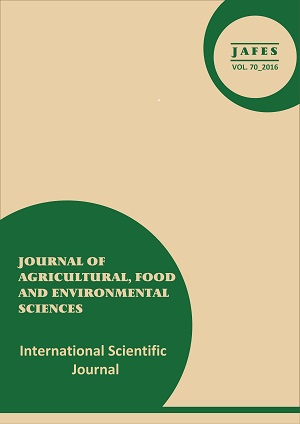DIFFERENT APPROACHES IN THE IDENTIFICATION OF MEAT ORIGIN BASED ON PROTEIN PROFILING AND SIMPLE PCR
Keywords:
meat, origin, DNA, protein, identificationAbstract
The meat origin, as a fundamental factor for the quality and the usability of its products, can be determined using DNA or protein analysis. In this study, different techniques are applied to determine the origin of different raw meat samples. The DNA analysis of meat is based on the Polymerase Chain Reaction whereas the techniques involving protein analysis are carried out using electrophoresis. Using the SDS-PAGE technique optimized by changing the running conditions, the amount of materials and the gel concentration, it is possible to differentiate different types of meat. We determine the differences in protein profile of poultry meat compared to the other samples in which are identified two specific fractions between 116 and 200 kD in the zone of myosin heavy chains and one bellow 45 kD in the zone of actin. In the beef samples there is a specific fraction in the zone of tropomyosin, while in pork and beef samples appeared a fraction in the zone of myosin light chain. This technique is suitable and can be only used for internal control in production and processing environments because of its low sensitivity. In practice, there are commercialized kits for the identification of meat and meat products based on DNA analysis. All those kits are dealing with specific primers for different type of meat (beef, pork, poultry, goat, horse, etc). In this case we used the primers for ryanodine receptor gene 1 (RYR1) which protein is involved in calcium pathways of the skeletal muscle cells. We amplify DNA isolated from beef, pork and poultry and DNA analysis based on partial amplification of the RYR1 gene showed the difference between mammalian and poultry meat because there is no amplification on the DNA sample isolated from chicken meat.
References
Du M., McCormick R.J.: (2009) Applied Muscle Biology and Meat Science. Taylor an Francis Group. LLC
Gersten D.M. (1996), Gel Electrophoresis (Essential Techniques Series). New York: Wiley
Macdonald W. (2010) Laboratory Manual. Ohio State University. Department for animal Science.
Mullis K., Faloona F., Scharf S., Saiki R., Horn G., and Erlich H.: (1986) Specific enzymatic amplification of DNA in vitro. Polymerase chain reaction. Cold Spring Harbor Symp. Quant. Biology 51: 263,.
Поповски З., Танасковска Б., Мискоска – Милеска Е.: (2013) Прирачник за методи базирани на PCR. ФЗНХ – УКИМ
Irfan I., Arslan A.: (2007) Identification of Meat Species by Polymerase Chain Reaction Technique. Turkish Journal of Veterinary and Animal Science. 31 (3). p. 159-163
Popovski Z., Tanaskovska B., Porchu K., Vukovic V., Andonov S., Palasevski B, (2002).: New Approach in Detection of Porcine Stress Syndrome. Biotechnology in Animal Husbandry, 18 (5-6), p. 73-80



